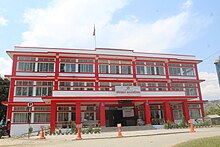This article possibly contains original research. (September 2021) |
Panchkhal (Nepali: पाँचखाल) is a Municipality in Kavrepalanchok District in the Bagmati Province of central Nepal. Panchkhal has an area of 103 km2 and population density of 386.6/km2, according to the 2011 census.[3] Glacial strand retreat and fluvial incision led to develop landscapes and evolve the area having a relief of about 122 to 750 m.[4] At the time of the 2011 Nepal census it had a population of 35340 in 8948 households combining of the previous VDCs that were merged.[5] Previous Aniakot, HokseBazar, Kharelthok, Koshidekha, Baluwa & Panchkhal VDCs was merged to form the agriculturally rich Panchkhal[6] Municipality with the motto of "पाँचखाल नगर, कृषि शहर (Panchkhal Municipal-Agriculture City)".
Panchkhal
पाँचखाल | |
|---|---|
 Panchkhal Municipality view with its capital and fertile fields | |
| Coordinates: 27°39′N 85°37′E / 27.650°N 85.617°E | |
| Country | Nepal |
| Province | Bagmati Province |
| District | Kavrepalanchok District |
| Government | |
| • Mayor | Mahesh Kharel |
| • Deputy Mayor | Surya Maya Danuwar |
| Population (2022) | |
| • Total | 42,011 |
| Time zone | UTC+5:45 (NST) |
| Postal code | 45212[1] |
| Area code | 011 |
| Website | www |

Demographics
editAt the time of the 2011 Nepal census, Panchkhal Municipality had a population of 39,788. Of these, 76.6% spoke Nepali, 20.9% Tamang, 11.6% Danuwar, 8.6% Newar, 0.3% Maithili, 0.2% Bhojpuri, 0.2% Rai, 0.1% Hindi, 0.1% Magar and 0.2% other languages as their first language.[7]
In terms of ethnicity/caste, 25.7% were Hill Brahmin, 21.8% Tamang, 13.3% Danuwar, 11.3% Newar, 9.1% Chhetri, 5.0% Sarki, 3.5% Kami, 2.1% Damai/Dholi, 1.6% Magar, 1.6% Sanyasi/Dasnami, 1.4% Gharti/Bhujel, 1.0% Thakuri, 0.6% Pahari, 0.3% other Dalit, 0.3% Limbu, 0.2% Kathabaniyan, 0.2% Rai, 0.2% Sunuwar, 0.1% Hajam/Thakur, 0.1% Kalwar, 0.1% Musalman, 0.1% Tharu and 0.4% others.[8]
In terms of religion, 83.4% were Hindu, 20.3% Buddhist, 3.4% Prakriti, 2.9% Christian, 0.1% Muslim and 0.3% others.[9]
In terms of literacy, 70.0% could read and write, 2.7% could only read and 27.2% could neither read nor write.[10]
Climate
editPanchkhal has average temperatures of 24.9 °C and the average low is 11.66 °C throughout the year. Temperatures may rise up to 38 °C in the summer season and winters are generally dry with a record low temperature of -10 °C in 2008. Average rainfall is about 10.2 cm throughout the year. Rainfall is mostly monsoon-based (about 65% of the annual rainfall occurs during the monsoon months of June to August) and it decreases substantially (100 to 200 cm (39 to 79 in)) from eastern Nepal to western Nepal. In the winter season it rarely rains which creates harsh conditions for farmers who mainly depend on rain for irrigation.[11]
Economy
editTourism
editPanchkhal is near to one of the reputed tourist destination of the country, Dhulikhel and Panauti, and its natural environment and the culture and traditions of the people living here attracts tourists.[citation needed] Panchkhal shares some resorts with Dhulikhel.
Special Economic Zone
editA budget of Rs 1.2 billion has been estimated for the construction of SEZ in Panchkhal. The construction of infrastructure at the Panchkhal economic zone, touted as a major facility to promote trade with China. The government has already acquired 1,000 ropanis of land—600 ropanis from the Devisthan Padula Subarnashwori Community Forest and 400 ropanis from the Sikharpur Community Forest. The Industry Ministry has paid Rs200 million to the Ministry of Forest for the land. If the SEZ is brought into operation, more than 50 large factories can be operated there. It can also provide warehousing facilities for goods imported from China.[12]
The Nepal government has a plan to add oil depots in Panchkhal.[13]
Educational facilities
editSome of the schools in Panchkhal Municipality
Army Base
editNepal Army Birendra Peace Operations Training Centre (BPOTC) is a training institute of Nepal which is dedicated for providing training to all Nepalese Army personnel participating in various UNPKO.[15]
The Nepalese Army established an ad hoc "Peace Keeping Training Camp" in 1986, which was subsequently restructured into a dedicated Training centre in 2001. It was renamed as Birendra Peace Operations Training Center with the motto "PEACE WITH HONOUR".[16]
References
edit- ^ "Postal Services Department". Archived from the original on 19 July 2011. Retrieved 19 May 2011.
- ^ "थप ४१ नगरपालिका घोषणा". कान्तिपुर दैनिक. Archived from the original on 15 August 2011.
- ^ "Panchkhal (Municipality, Nepal) - Population Statistics, Charts, Map and Location". www.citypopulation.de. Retrieved 3 February 2018.
- ^ Timsina, Yadu Nath; Adhikary, Prakash Chandra (2007). "Quaternary stratigraphy of Panchkhal valley, Central Nepal". Bulletin of the Department of Geology. 10: 1–8. doi:10.3126/bdg.v10i0.1415. ISSN 1996-3491.
- ^ "Nepal Census 2011" (PDF). Nepal Census. Retrieved 31 May 2017.
- ^ "Panchkhal Municipality Office | Government of Nepal". www.panchkhalmun.gov.np. Retrieved 30 May 2017.
- ^ NepalMap Language
- ^ NepalMap Caste
- ^ NepalMap Religion
- ^ NepalMap Literacy
- ^ "High and dry - Nepali Times". nepalitimes.com. Retrieved 31 May 2017.
- ^ "Panchkhal SEZ project formally recommences". Retrieved 31 May 2017.
- ^ "2 more oil depots to be built to boost reserves". Retrieved 31 May 2017.
- ^ "Sarbamangala Higher Secondary School Panchkhal-4 Kavrepalanchok". edusanjal.com. Retrieved 30 May 2017.
- ^ Ghimire, Binod. "UN accredits Nepal Army training centre in Kavre". kathmandupost.com. Retrieved 25 October 2018.
- ^ "Birendra Peace Operations Training Centre". bpotc.mil.np. Retrieved 30 May 2017.
